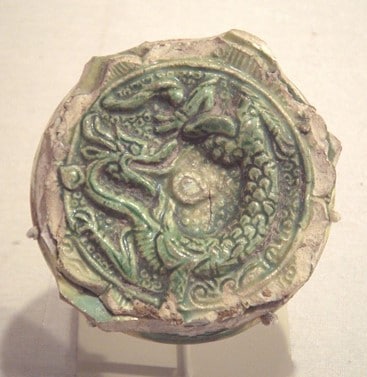Antiquarians digging in various ancient and fabled Middle East cities – Nishapur, Ctesiphon, Samarra, Homs, Raqqa – have found ancient Chinese ceramics laboriously brought along the Silk Road to their destinations. The Silk Route across Asia, from China to Europe, is over two thousand years old, and along it traveled goods and ideas, in both directions: silk from China, Buddhism and Nestorian Christianity, Roman silver, Bactrian horses from the West to the East. China traded with Rome and Byzantium and with the empires of Islam. China's weakness in the Early Modern Era and the rise of European mercantile empires (15th to 19th century) eclipsed this ancient trade route. But now it has returned with a vengeance.

Ancient Chinese seal found in the ruins of the Iranian city of Nishapur
Today, Chinese commercial and political ambitions spread globally, but especially towards the West across the Eurasian landmass. A recently inaugurated (December 2020) rail link connects Istanbul in European Turkey to Xian in western China, 8,693 kilometers (5,402 miles). This was a connection eagerly sought not just by China but by Turkey. As the U.S. seeks to pivot away from the Middle East, China pivots towards Western Asia, particularly seeking to build or maintain multi-faced "win-win" (as the Chinese like to say) relationships with authoritarian regimes in Turkey, Iran, and Pakistan. One of the reasons COVID-19 spread early to Iran in early 2020 was because of both Iran-China business and religious ties.
And China is not ignoring the Arab world either. China's economic power there is being augmented by an investment in soft power, in both Arabic-language media and in government-sponsored relationship building. This has garnered tangible benefits, as Arab governments have downplayed China's repression of its Uyghur Muslims.
Throughout the region, China is now able to present itself as the great enabler, the enticing alternative and non-judgmental partner – unlike those constantly commenting Americans and Europeans – who won't criticize or interfere in sensitive internal affairs but who is interested in business, making money, and cementing relationships with any regime no matter how odiously it treats its own people. In a sense, it functions like Russia in its relationship with the Middle East, without the direct military intervention but with more comprehensive relationships and with better infrastructure projects, at cheaper prices!
So, it all converges. To understand the Middle East region better, to understand the world better, a greater and more nuanced understanding of China, the people and the regime's motivations and narrative, their view of the other, of both West and East, is essential. China has also clearly emerged as the great new geostrategic rival to the U.S. – not just in the Middle East, but globally. When anti-U.S. regimes in the western hemisphere, like Cuba and Venezuela, look for succor, they look to China. It is not a Middle East challenge, but a global one. This is why, in later 2020, MEMRI launched its Chinese Media Studies Project.[1]
While MEMRI remains deeply committed and focused on our original mission of analyzing and investigating Middle East trends, in early 2016 we added Russian as a priority language.[2] This was before Russia became an issue of broad, sometimes partisan, discourse in the U.S., but after it moved into Syria to tilt the balance of power in that war in favor of the Assad regime.
No sound policy in democratic countries should be built upon an information void. To be sure, Western governments have their own classified sources of information, and there are well-established public experts on China. But in order to have public support for any given policy, this knowledge void has to be addressed with at least four main audiences: media, academia, legislatures, and the public at large. Only when these audiences in democratic societies have the informational basis to decide to support a certain worldview can policies be successfully formulated and implemented. In this sense, covering China is more than a regional challenge, given the breadth of Chinese economic penetration and influence operations that it has carried out – not just in the Middle East, but in the West itself. From Hollywood to corporate America to academe, the Chinese Communist Party (CCP) and its organs have also focused on soft power in the West.
Open-source materials such as newspapers, broadcast media, social media and textbooks constitute some of the essential building blocks for policy formulation. Broad sectors of public opinion, even in narrow categories such as academia or legislatures, can often encounter a void of information on specific subjects that can inform audiences. And even worse than a lack of information is content that is skewed for political reasons.
For the past 21 years, MEMRI has sought to fill that void in regard to the Arab and Muslim world, by providing timely and impactful open-source material in English to Western audiences about the reality of the Middle East. This material has served in shaping policy and enriching the public debate on issues of concern, such as terrorism, the rise of Islamist extremism, social and political trends, and the ongoing struggle of a wide range of Muslim reformers in the region to be heard.
Monitoring the intense public and official discourse within China related to the West, and to the Middle East, is now an important and timely complement to that which is taking place in Arabic, Farsi, Turkish, Urdu and Russian. More than an area of geographic focus, MEMRI is a concept that has shown its value over time: concentrating on a rising source of conflict and unmasking and analyzing it through those public voices – media, textbooks, sermons – that help in understanding the basic reality of a political development. China and voices in Chinese certainly deserve that attention today.
*Yigal Carmon is President and founder of MEMRI; Alberto M. Fernandez is Vice President of MEMRI.




